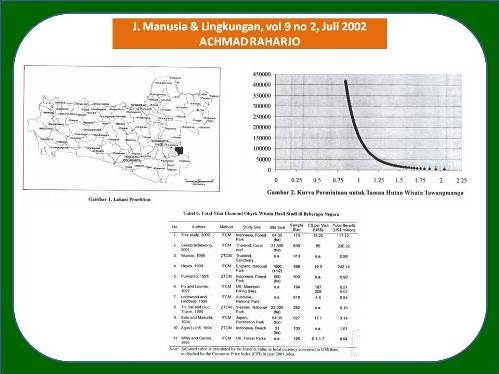
MENAKSIR NILAI EKONOMI TAMAN HUTAN WISATA TAWANGMANGU: APLIKASI INDIVIDUAL TRAVEL COST METHOD (Estimating the Economic Value of Tawangmangu Tourism Forest: An Application of the Travel Cost Method)
Achmad Raharjo(1*)
(1) Bappeda Sleman
(*) Corresponding Author
Abstract
ABSTRAK
Studi ini merupakan kajian dalam rangka penerapan salah satu dari metode valuasi lingkungan, individual travel cost method (ITCM), yang implementasinya menggantungkan data masing-masing individu. Untuk kajian ini dipilih Taman Hutan Wisata Twangmangu yang merupakan salah satu obyek wisata hutan terkenal khususnya di Jawa. Selanjutnya, untuk pentahapan pengumpulan data dilakukan survei langsung (wawancara) berasar kuesioner kepada pengunjung. Diasumsikan, nilai valuasi ekonomi hasil penerapan ITCM di negara berkembang mungkin lebih kecil angkanya bila dibandingkan studi serupa di negara maju akibat perbedaan karakteristik sosial-ekonomi masyarakatnya. Oleh karenanya, hipotesis studi ini adalah jumlah kunjungan ke obyek wisata (rekreasi) juga relatife lebih sedikit sebagai akibat tingkat kesejahteraan masyarakat yang relatife lebih rendah dibandingkan masyarakat negara maju. Dari kondisi tersebut, nilai keuntungan kegiatan rekreasi yang dicerminakn dengan agregat consumer surlus (CS) juga akan kecil. Studi ini menunjukkan bahwa nilai keuntungan rata-rata sebesar US$41.50 per tahun per individu atau sebesar US$18.20 per individu setiap kunjungan. Total nilai ekonomi Taman Hutan Wisata Tawangmangu adalah US$7.51 juta. Nilai hasil studi ini comparable terhadap studi-studi serupa di beberapa negara maju maupun negara sedang berkembang di Asia.
ABSTRACT
The study applied the Individual Travel Cost Method (ITCM) as one of the available environmental evaluation methods. The implementation of ITCM depends on individual data. Tawangmangu Tourism Forest, a well-known tourism forest in Java, was selected as the study area. The data were collected by directly interviewingthe visitors. It was assumed the values as a result of ITCM application in developing countries were lower than those in developed countries because of their different socio-economic characteristics. Therefore, the hypothesis of this study was just adjusted: the number of the visitors to the tourism objects is lower as a consequence of the lower people welfare compared to that of developed countries. Based on this condition, benefit obtained from recreation activities reflected by consumer surplusa aggregate (CS) will also small. This study shows that the average economic benefit was US$ 41.50 per year per individual or US$ 18.20 per individual in each visit. The total economic values of Tawangmangu tourism forest was US$ 7.51 millions. This value is comparable to the values of similar studies conducted in other countries.
Full Text:
Artikel lengkap (PDF) (Bahasa Indonesia)Article Metrics
Refbacks
- There are currently no refbacks.
Copyright (c) 2017 Jurnal Manusia dan Lingkungan







